Reflective Report: International HRM Concepts, Theories, and Practice
VerifiedAdded on 2023/01/18
|19
|5319
|67
Report
AI Summary
This report provides a reflective learning analysis of International Human Resource Management (IHRM). It begins with an introduction to IHRM, defining its role in multinational organizations, and highlighting the differences between national and international HRM. Task 1 critically compares IHRM concepts and theories, including definitions, objectives, practices, and the differences between domestic and international HRM. It also explores the dimensions of IHRM and the impact of environmental and cultural differences, including Hofstede's cultural dimensions and the convergence and divergence of IHRM practices. The report also discusses expatriate management. Task 2 critiques the use of the HRM function in an international context, examining challenges, commitment, cost-effectiveness, competence, and congruence. The report concludes by summarizing the key findings and insights gained from the analysis.
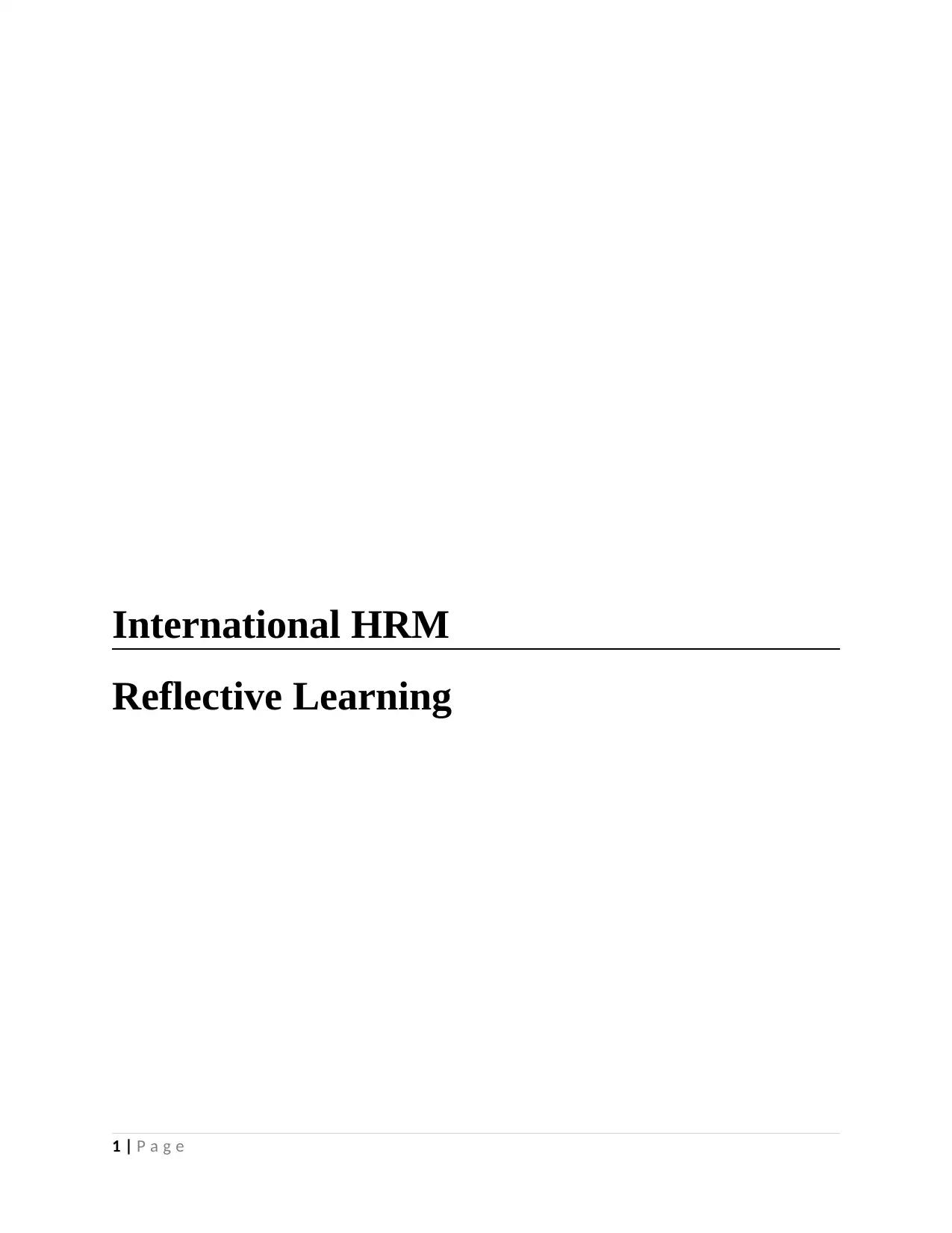
International HRM
Reflective Learning
1 | P a g e
Reflective Learning
1 | P a g e
Paraphrase This Document
Need a fresh take? Get an instant paraphrase of this document with our AI Paraphraser
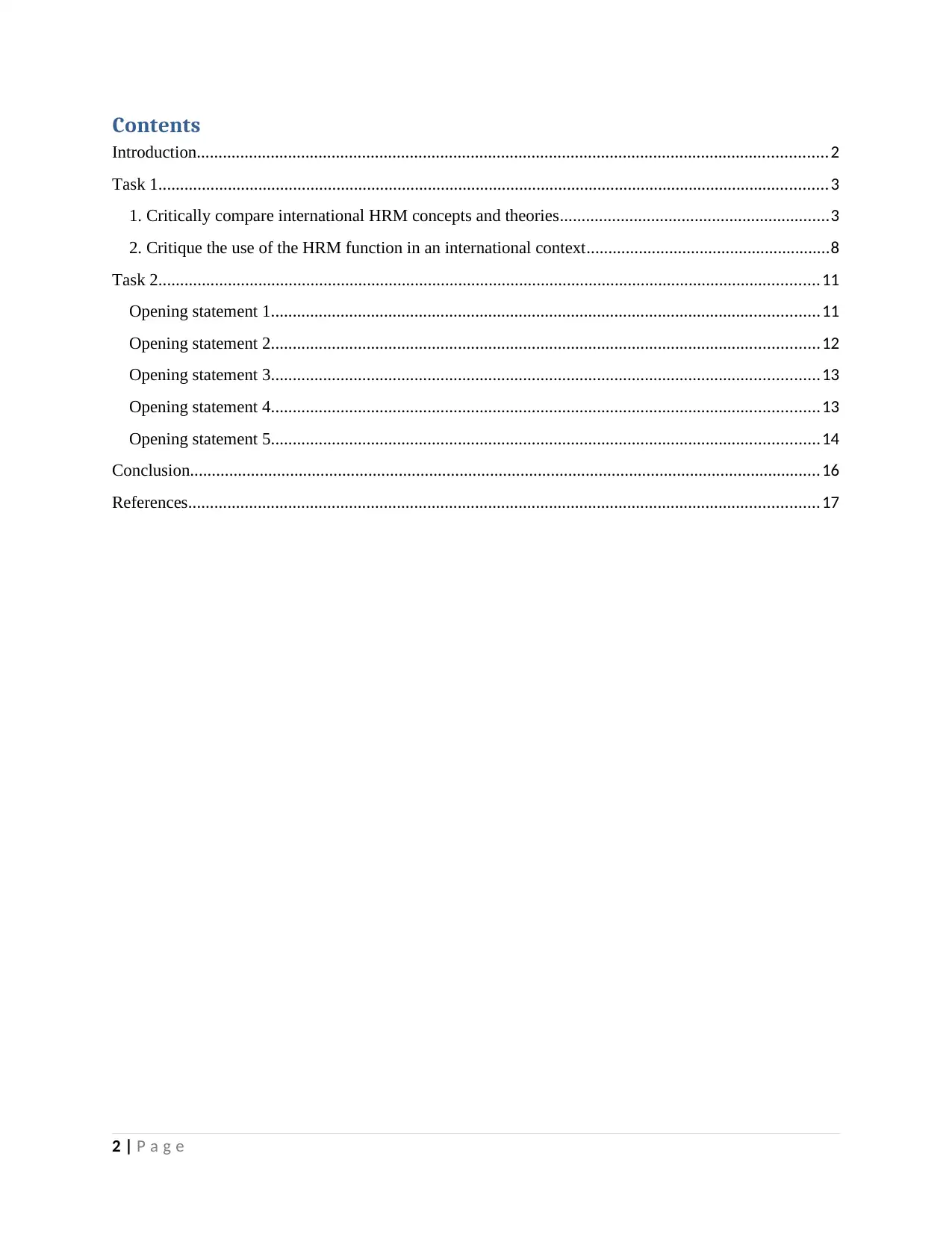
Contents
Introduction.................................................................................................................................................2
Task 1..........................................................................................................................................................3
1. Critically compare international HRM concepts and theories..............................................................3
2. Critique the use of the HRM function in an international context........................................................8
Task 2........................................................................................................................................................11
Opening statement 1..............................................................................................................................11
Opening statement 2..............................................................................................................................12
Opening statement 3..............................................................................................................................13
Opening statement 4..............................................................................................................................13
Opening statement 5..............................................................................................................................14
Conclusion.................................................................................................................................................16
References.................................................................................................................................................17
2 | P a g e
Introduction.................................................................................................................................................2
Task 1..........................................................................................................................................................3
1. Critically compare international HRM concepts and theories..............................................................3
2. Critique the use of the HRM function in an international context........................................................8
Task 2........................................................................................................................................................11
Opening statement 1..............................................................................................................................11
Opening statement 2..............................................................................................................................12
Opening statement 3..............................................................................................................................13
Opening statement 4..............................................................................................................................13
Opening statement 5..............................................................................................................................14
Conclusion.................................................................................................................................................16
References.................................................................................................................................................17
2 | P a g e
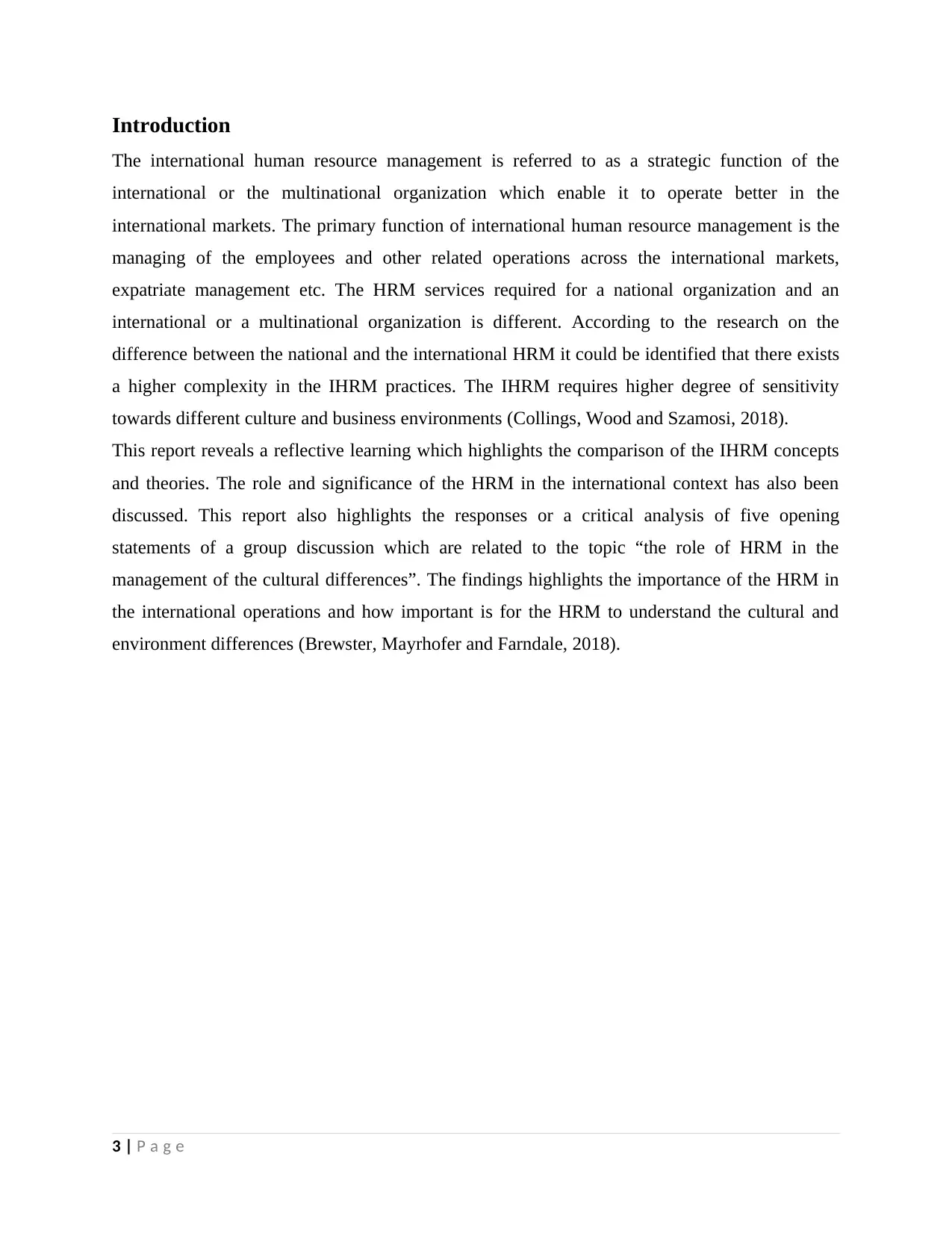
Introduction
The international human resource management is referred to as a strategic function of the
international or the multinational organization which enable it to operate better in the
international markets. The primary function of international human resource management is the
managing of the employees and other related operations across the international markets,
expatriate management etc. The HRM services required for a national organization and an
international or a multinational organization is different. According to the research on the
difference between the national and the international HRM it could be identified that there exists
a higher complexity in the IHRM practices. The IHRM requires higher degree of sensitivity
towards different culture and business environments (Collings, Wood and Szamosi, 2018).
This report reveals a reflective learning which highlights the comparison of the IHRM concepts
and theories. The role and significance of the HRM in the international context has also been
discussed. This report also highlights the responses or a critical analysis of five opening
statements of a group discussion which are related to the topic “the role of HRM in the
management of the cultural differences”. The findings highlights the importance of the HRM in
the international operations and how important is for the HRM to understand the cultural and
environment differences (Brewster, Mayrhofer and Farndale, 2018).
3 | P a g e
The international human resource management is referred to as a strategic function of the
international or the multinational organization which enable it to operate better in the
international markets. The primary function of international human resource management is the
managing of the employees and other related operations across the international markets,
expatriate management etc. The HRM services required for a national organization and an
international or a multinational organization is different. According to the research on the
difference between the national and the international HRM it could be identified that there exists
a higher complexity in the IHRM practices. The IHRM requires higher degree of sensitivity
towards different culture and business environments (Collings, Wood and Szamosi, 2018).
This report reveals a reflective learning which highlights the comparison of the IHRM concepts
and theories. The role and significance of the HRM in the international context has also been
discussed. This report also highlights the responses or a critical analysis of five opening
statements of a group discussion which are related to the topic “the role of HRM in the
management of the cultural differences”. The findings highlights the importance of the HRM in
the international operations and how important is for the HRM to understand the cultural and
environment differences (Brewster, Mayrhofer and Farndale, 2018).
3 | P a g e
⊘ This is a preview!⊘
Do you want full access?
Subscribe today to unlock all pages.

Trusted by 1+ million students worldwide
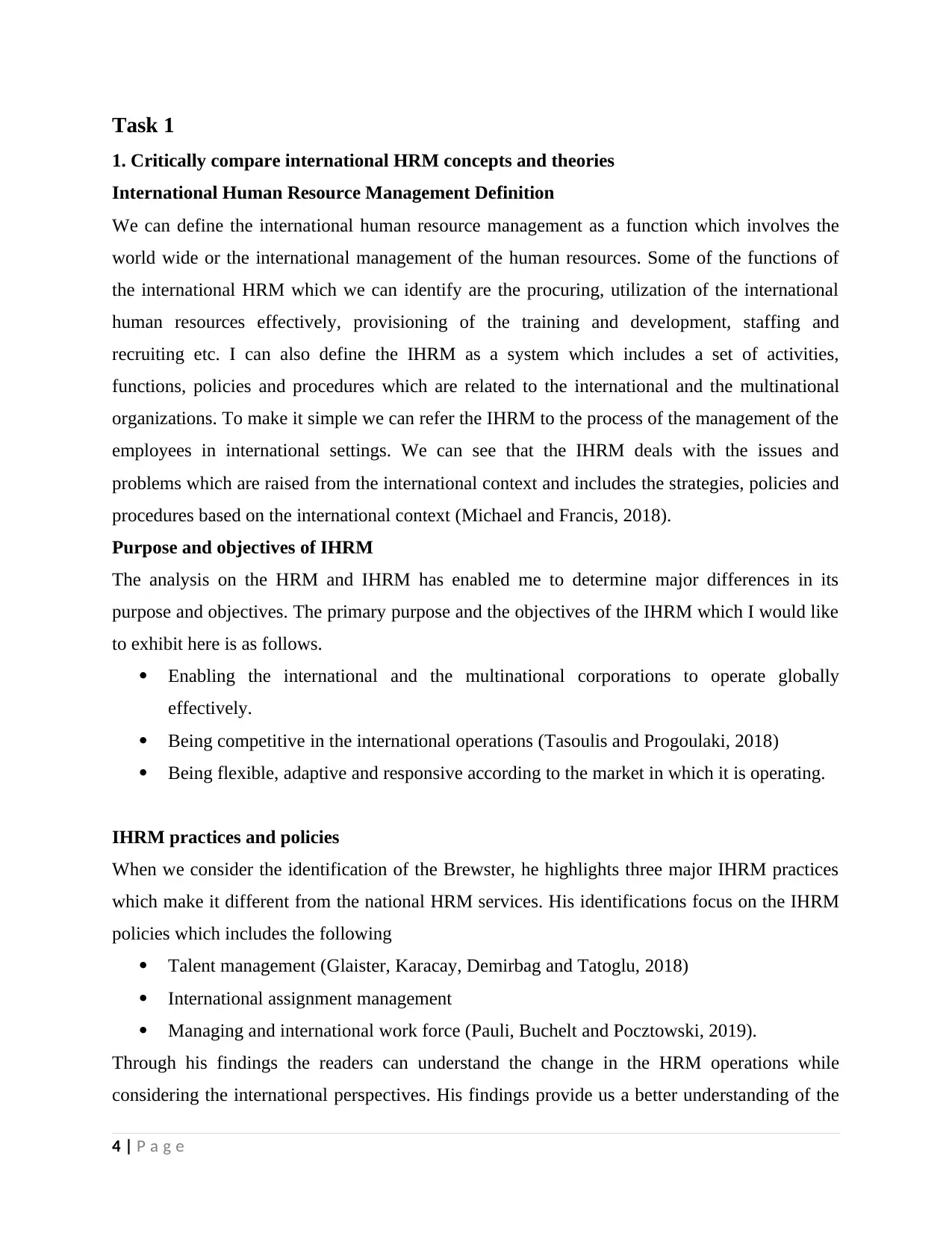
Task 1
1. Critically compare international HRM concepts and theories
International Human Resource Management Definition
We can define the international human resource management as a function which involves the
world wide or the international management of the human resources. Some of the functions of
the international HRM which we can identify are the procuring, utilization of the international
human resources effectively, provisioning of the training and development, staffing and
recruiting etc. I can also define the IHRM as a system which includes a set of activities,
functions, policies and procedures which are related to the international and the multinational
organizations. To make it simple we can refer the IHRM to the process of the management of the
employees in international settings. We can see that the IHRM deals with the issues and
problems which are raised from the international context and includes the strategies, policies and
procedures based on the international context (Michael and Francis, 2018).
Purpose and objectives of IHRM
The analysis on the HRM and IHRM has enabled me to determine major differences in its
purpose and objectives. The primary purpose and the objectives of the IHRM which I would like
to exhibit here is as follows.
Enabling the international and the multinational corporations to operate globally
effectively.
Being competitive in the international operations (Tasoulis and Progoulaki, 2018)
Being flexible, adaptive and responsive according to the market in which it is operating.
IHRM practices and policies
When we consider the identification of the Brewster, he highlights three major IHRM practices
which make it different from the national HRM services. His identifications focus on the IHRM
policies which includes the following
Talent management (Glaister, Karacay, Demirbag and Tatoglu, 2018)
International assignment management
Managing and international work force (Pauli, Buchelt and Pocztowski, 2019).
Through his findings the readers can understand the change in the HRM operations while
considering the international perspectives. His findings provide us a better understanding of the
4 | P a g e
1. Critically compare international HRM concepts and theories
International Human Resource Management Definition
We can define the international human resource management as a function which involves the
world wide or the international management of the human resources. Some of the functions of
the international HRM which we can identify are the procuring, utilization of the international
human resources effectively, provisioning of the training and development, staffing and
recruiting etc. I can also define the IHRM as a system which includes a set of activities,
functions, policies and procedures which are related to the international and the multinational
organizations. To make it simple we can refer the IHRM to the process of the management of the
employees in international settings. We can see that the IHRM deals with the issues and
problems which are raised from the international context and includes the strategies, policies and
procedures based on the international context (Michael and Francis, 2018).
Purpose and objectives of IHRM
The analysis on the HRM and IHRM has enabled me to determine major differences in its
purpose and objectives. The primary purpose and the objectives of the IHRM which I would like
to exhibit here is as follows.
Enabling the international and the multinational corporations to operate globally
effectively.
Being competitive in the international operations (Tasoulis and Progoulaki, 2018)
Being flexible, adaptive and responsive according to the market in which it is operating.
IHRM practices and policies
When we consider the identification of the Brewster, he highlights three major IHRM practices
which make it different from the national HRM services. His identifications focus on the IHRM
policies which includes the following
Talent management (Glaister, Karacay, Demirbag and Tatoglu, 2018)
International assignment management
Managing and international work force (Pauli, Buchelt and Pocztowski, 2019).
Through his findings the readers can understand the change in the HRM operations while
considering the international perspectives. His findings provide us a better understanding of the
4 | P a g e
Paraphrase This Document
Need a fresh take? Get an instant paraphrase of this document with our AI Paraphraser
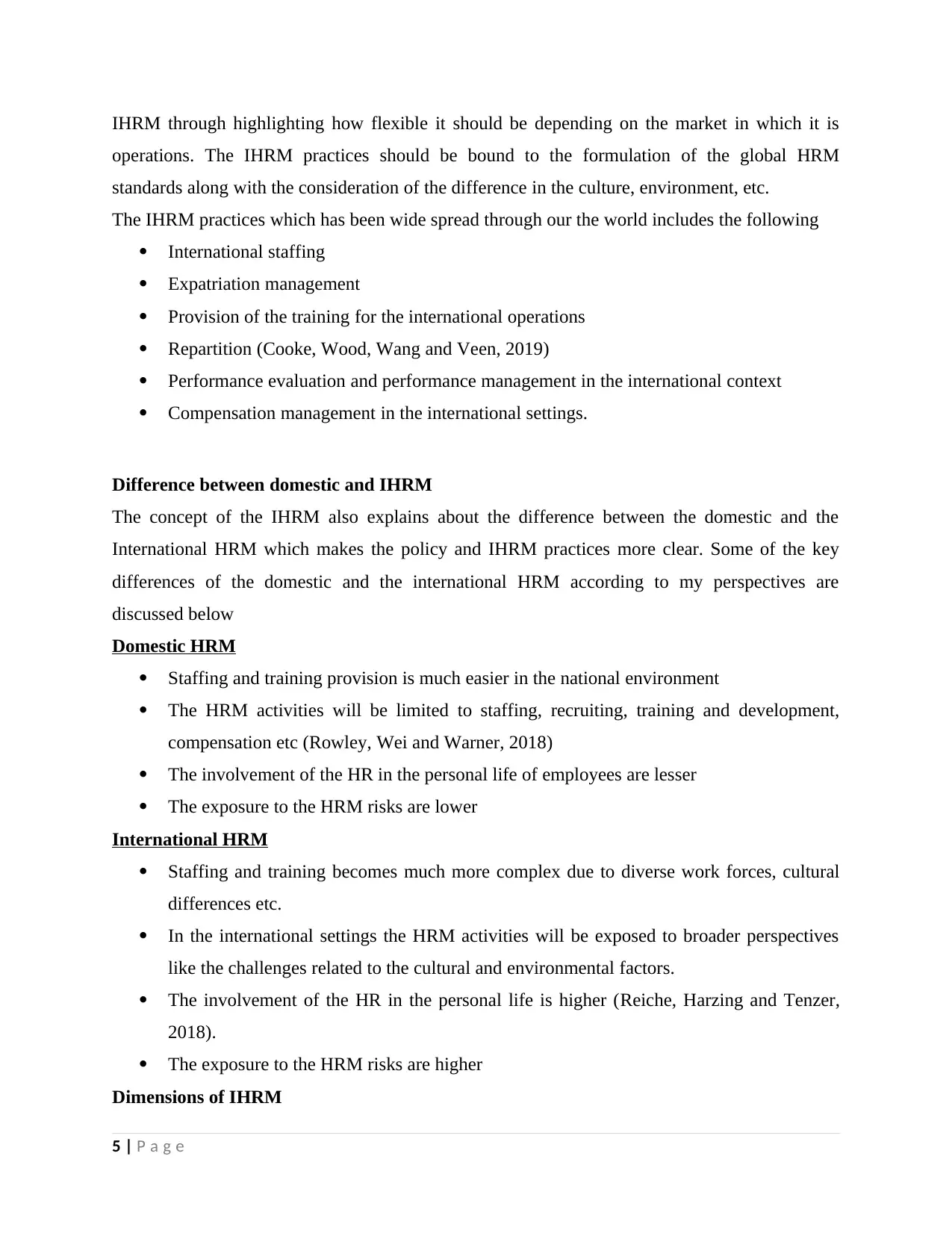
IHRM through highlighting how flexible it should be depending on the market in which it is
operations. The IHRM practices should be bound to the formulation of the global HRM
standards along with the consideration of the difference in the culture, environment, etc.
The IHRM practices which has been wide spread through our the world includes the following
International staffing
Expatriation management
Provision of the training for the international operations
Repartition (Cooke, Wood, Wang and Veen, 2019)
Performance evaluation and performance management in the international context
Compensation management in the international settings.
Difference between domestic and IHRM
The concept of the IHRM also explains about the difference between the domestic and the
International HRM which makes the policy and IHRM practices more clear. Some of the key
differences of the domestic and the international HRM according to my perspectives are
discussed below
Domestic HRM
Staffing and training provision is much easier in the national environment
The HRM activities will be limited to staffing, recruiting, training and development,
compensation etc (Rowley, Wei and Warner, 2018)
The involvement of the HR in the personal life of employees are lesser
The exposure to the HRM risks are lower
International HRM
Staffing and training becomes much more complex due to diverse work forces, cultural
differences etc.
In the international settings the HRM activities will be exposed to broader perspectives
like the challenges related to the cultural and environmental factors.
The involvement of the HR in the personal life is higher (Reiche, Harzing and Tenzer,
2018).
The exposure to the HRM risks are higher
Dimensions of IHRM
5 | P a g e
operations. The IHRM practices should be bound to the formulation of the global HRM
standards along with the consideration of the difference in the culture, environment, etc.
The IHRM practices which has been wide spread through our the world includes the following
International staffing
Expatriation management
Provision of the training for the international operations
Repartition (Cooke, Wood, Wang and Veen, 2019)
Performance evaluation and performance management in the international context
Compensation management in the international settings.
Difference between domestic and IHRM
The concept of the IHRM also explains about the difference between the domestic and the
International HRM which makes the policy and IHRM practices more clear. Some of the key
differences of the domestic and the international HRM according to my perspectives are
discussed below
Domestic HRM
Staffing and training provision is much easier in the national environment
The HRM activities will be limited to staffing, recruiting, training and development,
compensation etc (Rowley, Wei and Warner, 2018)
The involvement of the HR in the personal life of employees are lesser
The exposure to the HRM risks are lower
International HRM
Staffing and training becomes much more complex due to diverse work forces, cultural
differences etc.
In the international settings the HRM activities will be exposed to broader perspectives
like the challenges related to the cultural and environmental factors.
The involvement of the HR in the personal life is higher (Reiche, Harzing and Tenzer,
2018).
The exposure to the HRM risks are higher
Dimensions of IHRM
5 | P a g e
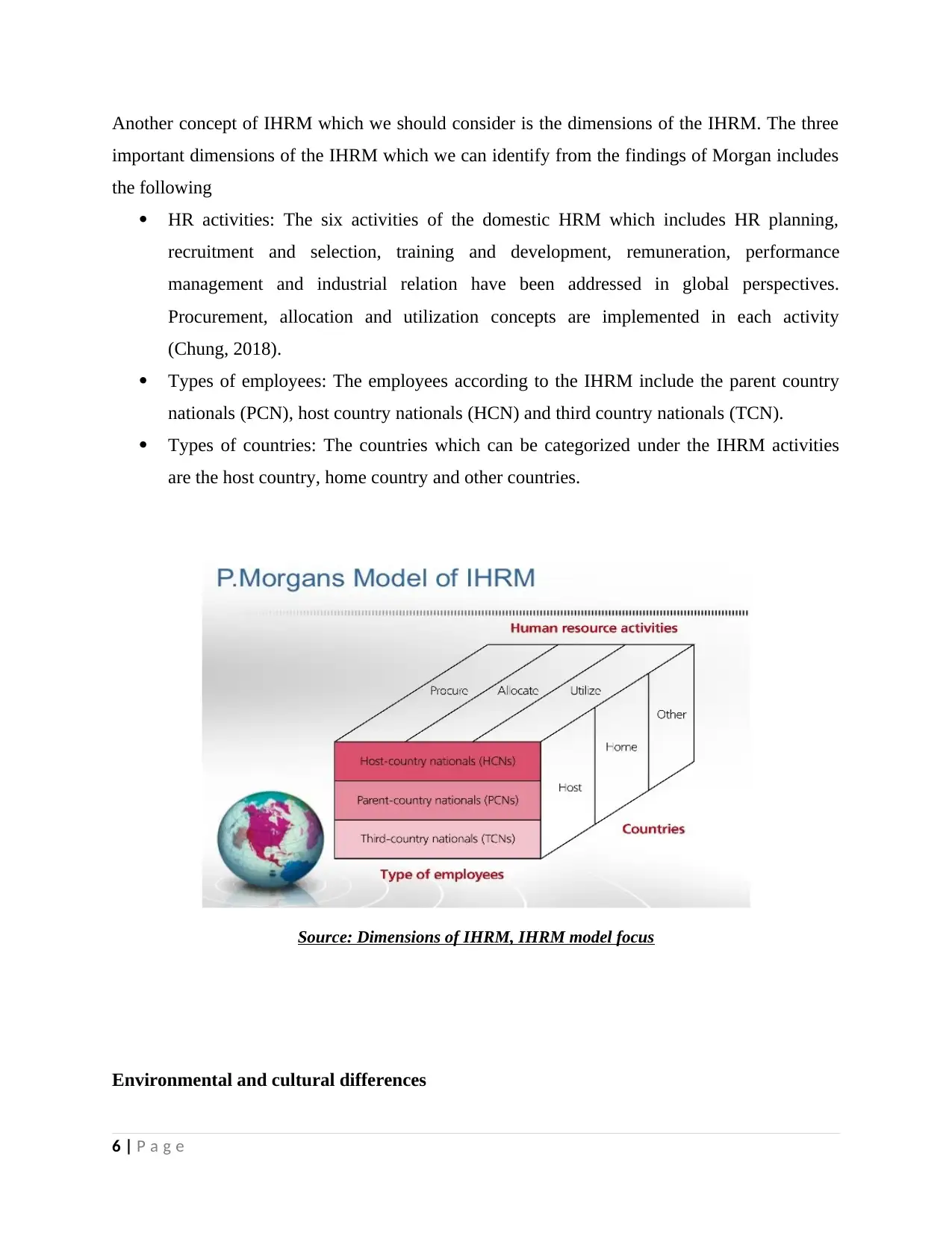
Another concept of IHRM which we should consider is the dimensions of the IHRM. The three
important dimensions of the IHRM which we can identify from the findings of Morgan includes
the following
HR activities: The six activities of the domestic HRM which includes HR planning,
recruitment and selection, training and development, remuneration, performance
management and industrial relation have been addressed in global perspectives.
Procurement, allocation and utilization concepts are implemented in each activity
(Chung, 2018).
Types of employees: The employees according to the IHRM include the parent country
nationals (PCN), host country nationals (HCN) and third country nationals (TCN).
Types of countries: The countries which can be categorized under the IHRM activities
are the host country, home country and other countries.
Source: Dimensions of IHRM, IHRM model focus
Environmental and cultural differences
6 | P a g e
important dimensions of the IHRM which we can identify from the findings of Morgan includes
the following
HR activities: The six activities of the domestic HRM which includes HR planning,
recruitment and selection, training and development, remuneration, performance
management and industrial relation have been addressed in global perspectives.
Procurement, allocation and utilization concepts are implemented in each activity
(Chung, 2018).
Types of employees: The employees according to the IHRM include the parent country
nationals (PCN), host country nationals (HCN) and third country nationals (TCN).
Types of countries: The countries which can be categorized under the IHRM activities
are the host country, home country and other countries.
Source: Dimensions of IHRM, IHRM model focus
Environmental and cultural differences
6 | P a g e
⊘ This is a preview!⊘
Do you want full access?
Subscribe today to unlock all pages.

Trusted by 1+ million students worldwide
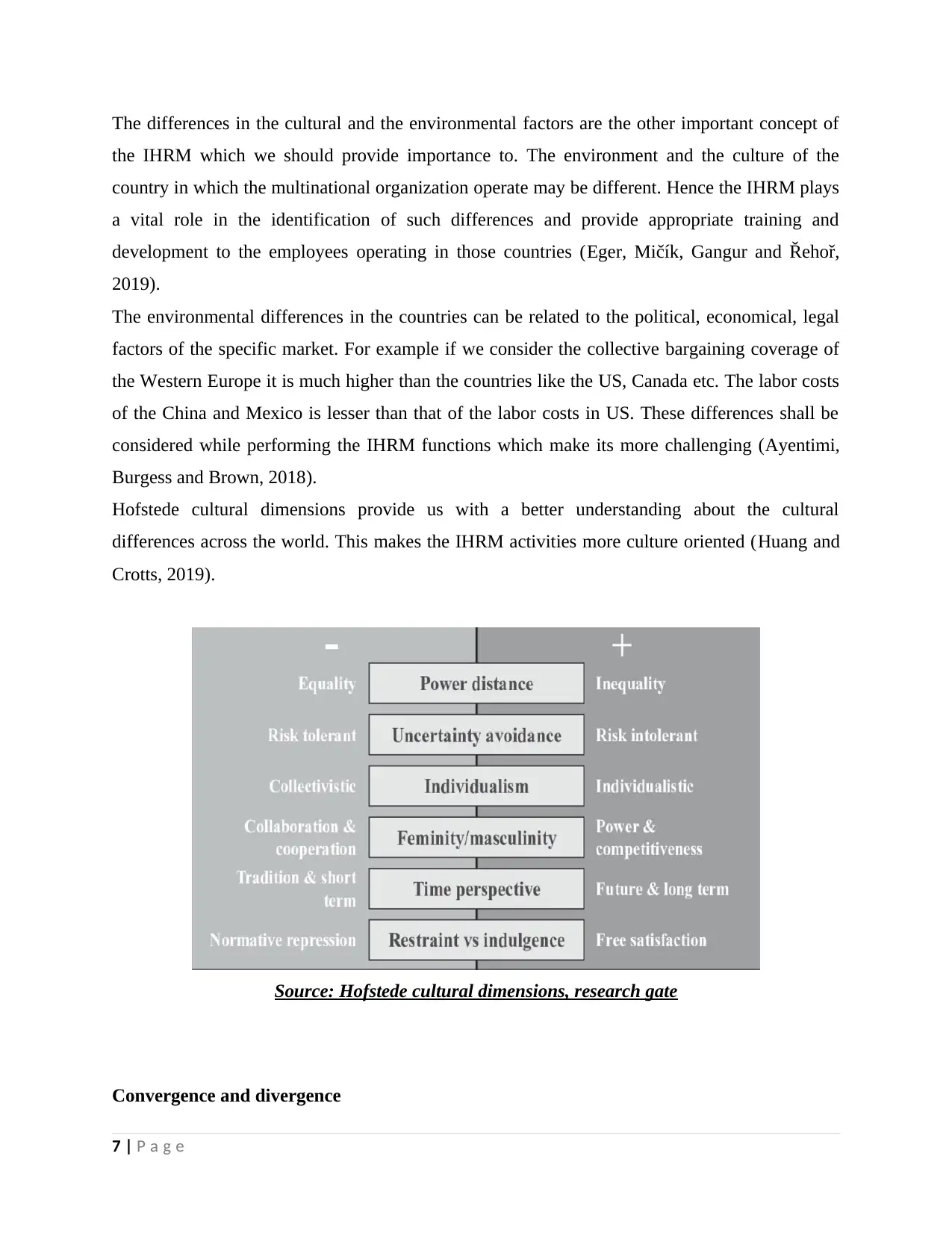
The differences in the cultural and the environmental factors are the other important concept of
the IHRM which we should provide importance to. The environment and the culture of the
country in which the multinational organization operate may be different. Hence the IHRM plays
a vital role in the identification of such differences and provide appropriate training and
development to the employees operating in those countries (Eger, Mičík, Gangur and Řehoř,
2019).
The environmental differences in the countries can be related to the political, economical, legal
factors of the specific market. For example if we consider the collective bargaining coverage of
the Western Europe it is much higher than the countries like the US, Canada etc. The labor costs
of the China and Mexico is lesser than that of the labor costs in US. These differences shall be
considered while performing the IHRM functions which make its more challenging (Ayentimi,
Burgess and Brown, 2018).
Hofstede cultural dimensions provide us with a better understanding about the cultural
differences across the world. This makes the IHRM activities more culture oriented (Huang and
Crotts, 2019).
Source: Hofstede cultural dimensions, research gate
Convergence and divergence
7 | P a g e
the IHRM which we should provide importance to. The environment and the culture of the
country in which the multinational organization operate may be different. Hence the IHRM plays
a vital role in the identification of such differences and provide appropriate training and
development to the employees operating in those countries (Eger, Mičík, Gangur and Řehoř,
2019).
The environmental differences in the countries can be related to the political, economical, legal
factors of the specific market. For example if we consider the collective bargaining coverage of
the Western Europe it is much higher than the countries like the US, Canada etc. The labor costs
of the China and Mexico is lesser than that of the labor costs in US. These differences shall be
considered while performing the IHRM functions which make its more challenging (Ayentimi,
Burgess and Brown, 2018).
Hofstede cultural dimensions provide us with a better understanding about the cultural
differences across the world. This makes the IHRM activities more culture oriented (Huang and
Crotts, 2019).
Source: Hofstede cultural dimensions, research gate
Convergence and divergence
7 | P a g e
Paraphrase This Document
Need a fresh take? Get an instant paraphrase of this document with our AI Paraphraser
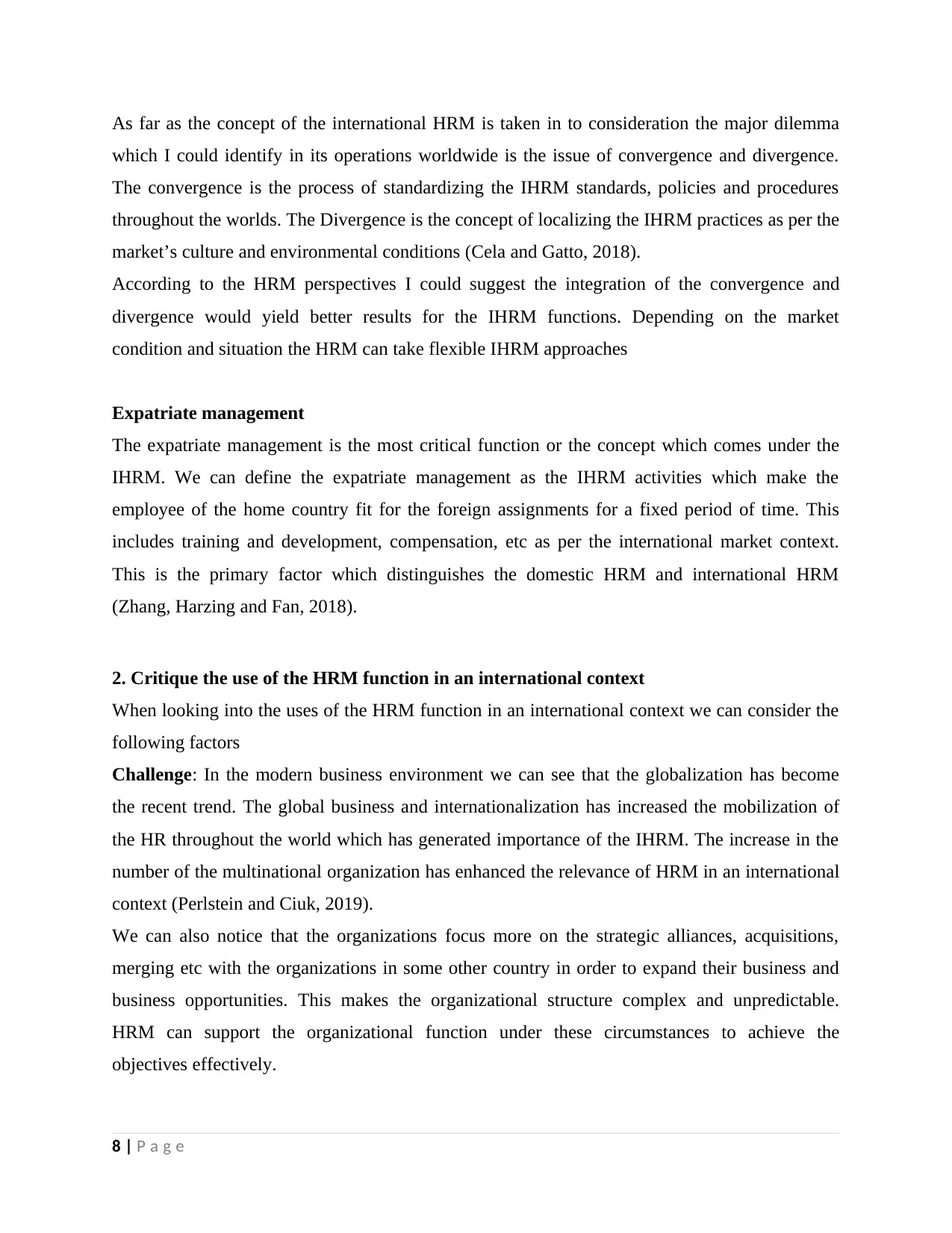
As far as the concept of the international HRM is taken in to consideration the major dilemma
which I could identify in its operations worldwide is the issue of convergence and divergence.
The convergence is the process of standardizing the IHRM standards, policies and procedures
throughout the worlds. The Divergence is the concept of localizing the IHRM practices as per the
market’s culture and environmental conditions (Cela and Gatto, 2018).
According to the HRM perspectives I could suggest the integration of the convergence and
divergence would yield better results for the IHRM functions. Depending on the market
condition and situation the HRM can take flexible IHRM approaches
Expatriate management
The expatriate management is the most critical function or the concept which comes under the
IHRM. We can define the expatriate management as the IHRM activities which make the
employee of the home country fit for the foreign assignments for a fixed period of time. This
includes training and development, compensation, etc as per the international market context.
This is the primary factor which distinguishes the domestic HRM and international HRM
(Zhang, Harzing and Fan, 2018).
2. Critique the use of the HRM function in an international context
When looking into the uses of the HRM function in an international context we can consider the
following factors
Challenge: In the modern business environment we can see that the globalization has become
the recent trend. The global business and internationalization has increased the mobilization of
the HR throughout the world which has generated importance of the IHRM. The increase in the
number of the multinational organization has enhanced the relevance of HRM in an international
context (Perlstein and Ciuk, 2019).
We can also notice that the organizations focus more on the strategic alliances, acquisitions,
merging etc with the organizations in some other country in order to expand their business and
business opportunities. This makes the organizational structure complex and unpredictable.
HRM can support the organizational function under these circumstances to achieve the
objectives effectively.
8 | P a g e
which I could identify in its operations worldwide is the issue of convergence and divergence.
The convergence is the process of standardizing the IHRM standards, policies and procedures
throughout the worlds. The Divergence is the concept of localizing the IHRM practices as per the
market’s culture and environmental conditions (Cela and Gatto, 2018).
According to the HRM perspectives I could suggest the integration of the convergence and
divergence would yield better results for the IHRM functions. Depending on the market
condition and situation the HRM can take flexible IHRM approaches
Expatriate management
The expatriate management is the most critical function or the concept which comes under the
IHRM. We can define the expatriate management as the IHRM activities which make the
employee of the home country fit for the foreign assignments for a fixed period of time. This
includes training and development, compensation, etc as per the international market context.
This is the primary factor which distinguishes the domestic HRM and international HRM
(Zhang, Harzing and Fan, 2018).
2. Critique the use of the HRM function in an international context
When looking into the uses of the HRM function in an international context we can consider the
following factors
Challenge: In the modern business environment we can see that the globalization has become
the recent trend. The global business and internationalization has increased the mobilization of
the HR throughout the world which has generated importance of the IHRM. The increase in the
number of the multinational organization has enhanced the relevance of HRM in an international
context (Perlstein and Ciuk, 2019).
We can also notice that the organizations focus more on the strategic alliances, acquisitions,
merging etc with the organizations in some other country in order to expand their business and
business opportunities. This makes the organizational structure complex and unpredictable.
HRM can support the organizational function under these circumstances to achieve the
objectives effectively.
8 | P a g e
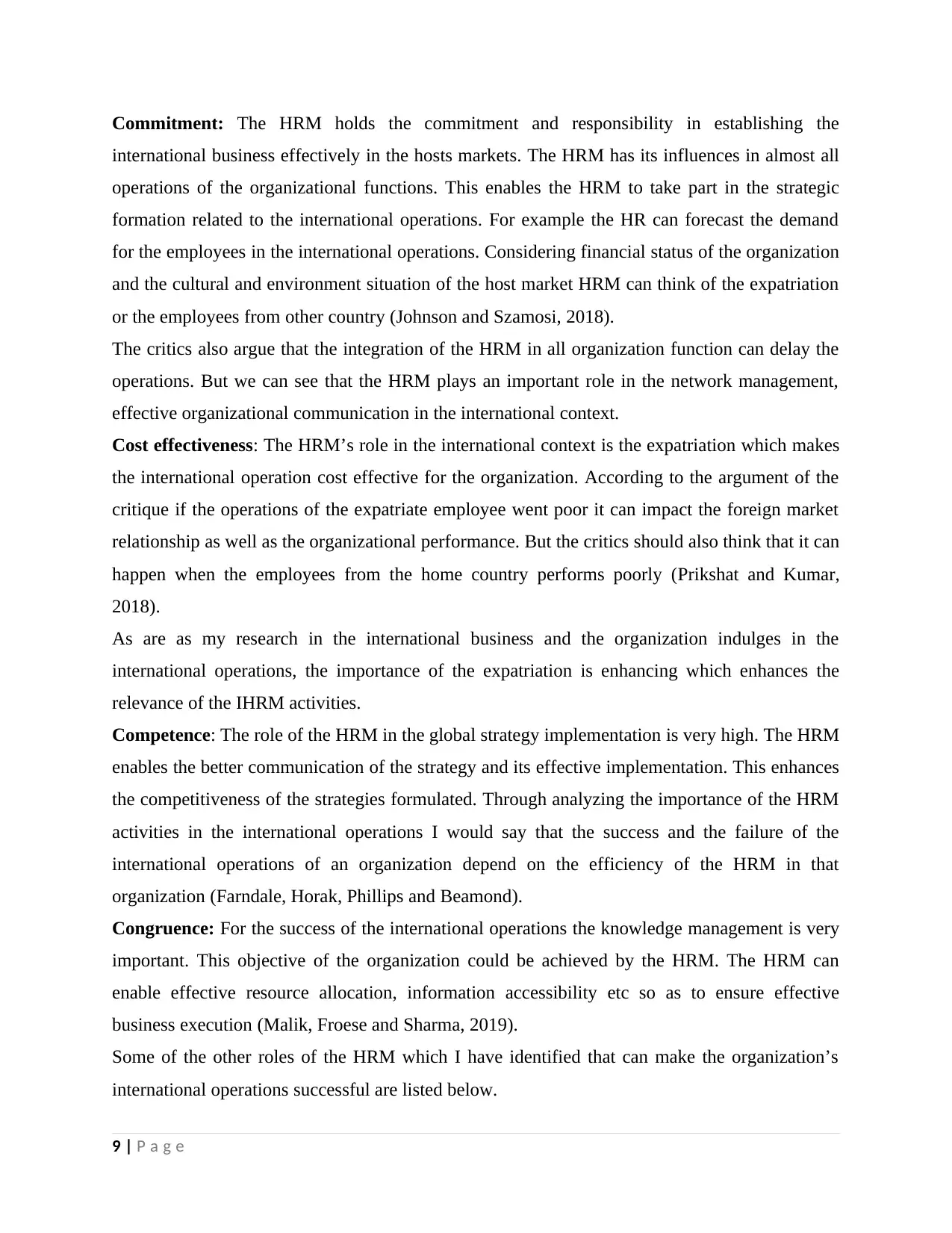
Commitment: The HRM holds the commitment and responsibility in establishing the
international business effectively in the hosts markets. The HRM has its influences in almost all
operations of the organizational functions. This enables the HRM to take part in the strategic
formation related to the international operations. For example the HR can forecast the demand
for the employees in the international operations. Considering financial status of the organization
and the cultural and environment situation of the host market HRM can think of the expatriation
or the employees from other country (Johnson and Szamosi, 2018).
The critics also argue that the integration of the HRM in all organization function can delay the
operations. But we can see that the HRM plays an important role in the network management,
effective organizational communication in the international context.
Cost effectiveness: The HRM’s role in the international context is the expatriation which makes
the international operation cost effective for the organization. According to the argument of the
critique if the operations of the expatriate employee went poor it can impact the foreign market
relationship as well as the organizational performance. But the critics should also think that it can
happen when the employees from the home country performs poorly (Prikshat and Kumar,
2018).
As are as my research in the international business and the organization indulges in the
international operations, the importance of the expatriation is enhancing which enhances the
relevance of the IHRM activities.
Competence: The role of the HRM in the global strategy implementation is very high. The HRM
enables the better communication of the strategy and its effective implementation. This enhances
the competitiveness of the strategies formulated. Through analyzing the importance of the HRM
activities in the international operations I would say that the success and the failure of the
international operations of an organization depend on the efficiency of the HRM in that
organization (Farndale, Horak, Phillips and Beamond).
Congruence: For the success of the international operations the knowledge management is very
important. This objective of the organization could be achieved by the HRM. The HRM can
enable effective resource allocation, information accessibility etc so as to ensure effective
business execution (Malik, Froese and Sharma, 2019).
Some of the other roles of the HRM which I have identified that can make the organization’s
international operations successful are listed below.
9 | P a g e
international business effectively in the hosts markets. The HRM has its influences in almost all
operations of the organizational functions. This enables the HRM to take part in the strategic
formation related to the international operations. For example the HR can forecast the demand
for the employees in the international operations. Considering financial status of the organization
and the cultural and environment situation of the host market HRM can think of the expatriation
or the employees from other country (Johnson and Szamosi, 2018).
The critics also argue that the integration of the HRM in all organization function can delay the
operations. But we can see that the HRM plays an important role in the network management,
effective organizational communication in the international context.
Cost effectiveness: The HRM’s role in the international context is the expatriation which makes
the international operation cost effective for the organization. According to the argument of the
critique if the operations of the expatriate employee went poor it can impact the foreign market
relationship as well as the organizational performance. But the critics should also think that it can
happen when the employees from the home country performs poorly (Prikshat and Kumar,
2018).
As are as my research in the international business and the organization indulges in the
international operations, the importance of the expatriation is enhancing which enhances the
relevance of the IHRM activities.
Competence: The role of the HRM in the global strategy implementation is very high. The HRM
enables the better communication of the strategy and its effective implementation. This enhances
the competitiveness of the strategies formulated. Through analyzing the importance of the HRM
activities in the international operations I would say that the success and the failure of the
international operations of an organization depend on the efficiency of the HRM in that
organization (Farndale, Horak, Phillips and Beamond).
Congruence: For the success of the international operations the knowledge management is very
important. This objective of the organization could be achieved by the HRM. The HRM can
enable effective resource allocation, information accessibility etc so as to ensure effective
business execution (Malik, Froese and Sharma, 2019).
Some of the other roles of the HRM which I have identified that can make the organization’s
international operations successful are listed below.
9 | P a g e
⊘ This is a preview!⊘
Do you want full access?
Subscribe today to unlock all pages.

Trusted by 1+ million students worldwide
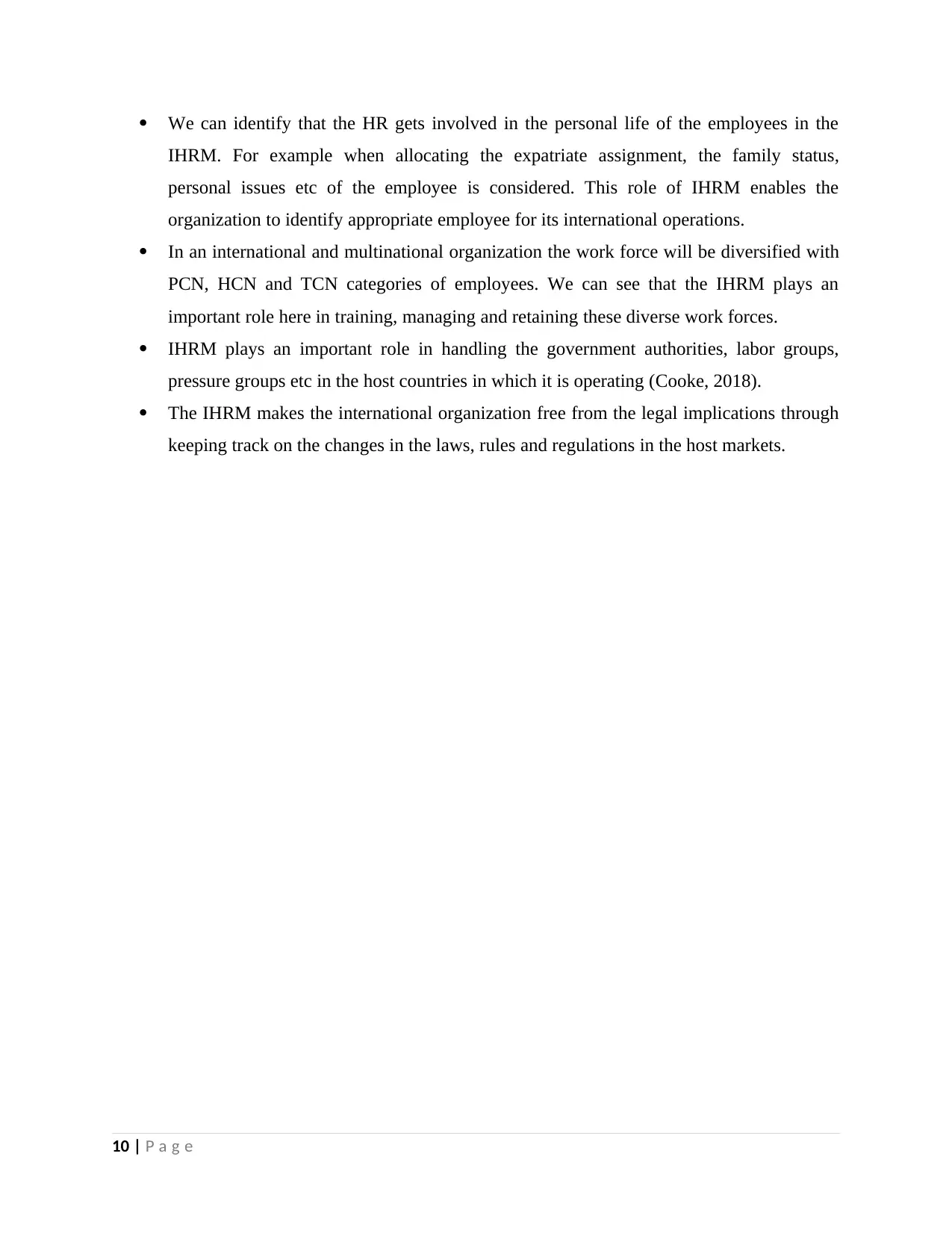
We can identify that the HR gets involved in the personal life of the employees in the
IHRM. For example when allocating the expatriate assignment, the family status,
personal issues etc of the employee is considered. This role of IHRM enables the
organization to identify appropriate employee for its international operations.
In an international and multinational organization the work force will be diversified with
PCN, HCN and TCN categories of employees. We can see that the IHRM plays an
important role here in training, managing and retaining these diverse work forces.
IHRM plays an important role in handling the government authorities, labor groups,
pressure groups etc in the host countries in which it is operating (Cooke, 2018).
The IHRM makes the international organization free from the legal implications through
keeping track on the changes in the laws, rules and regulations in the host markets.
10 | P a g e
IHRM. For example when allocating the expatriate assignment, the family status,
personal issues etc of the employee is considered. This role of IHRM enables the
organization to identify appropriate employee for its international operations.
In an international and multinational organization the work force will be diversified with
PCN, HCN and TCN categories of employees. We can see that the IHRM plays an
important role here in training, managing and retaining these diverse work forces.
IHRM plays an important role in handling the government authorities, labor groups,
pressure groups etc in the host countries in which it is operating (Cooke, 2018).
The IHRM makes the international organization free from the legal implications through
keeping track on the changes in the laws, rules and regulations in the host markets.
10 | P a g e
Paraphrase This Document
Need a fresh take? Get an instant paraphrase of this document with our AI Paraphraser
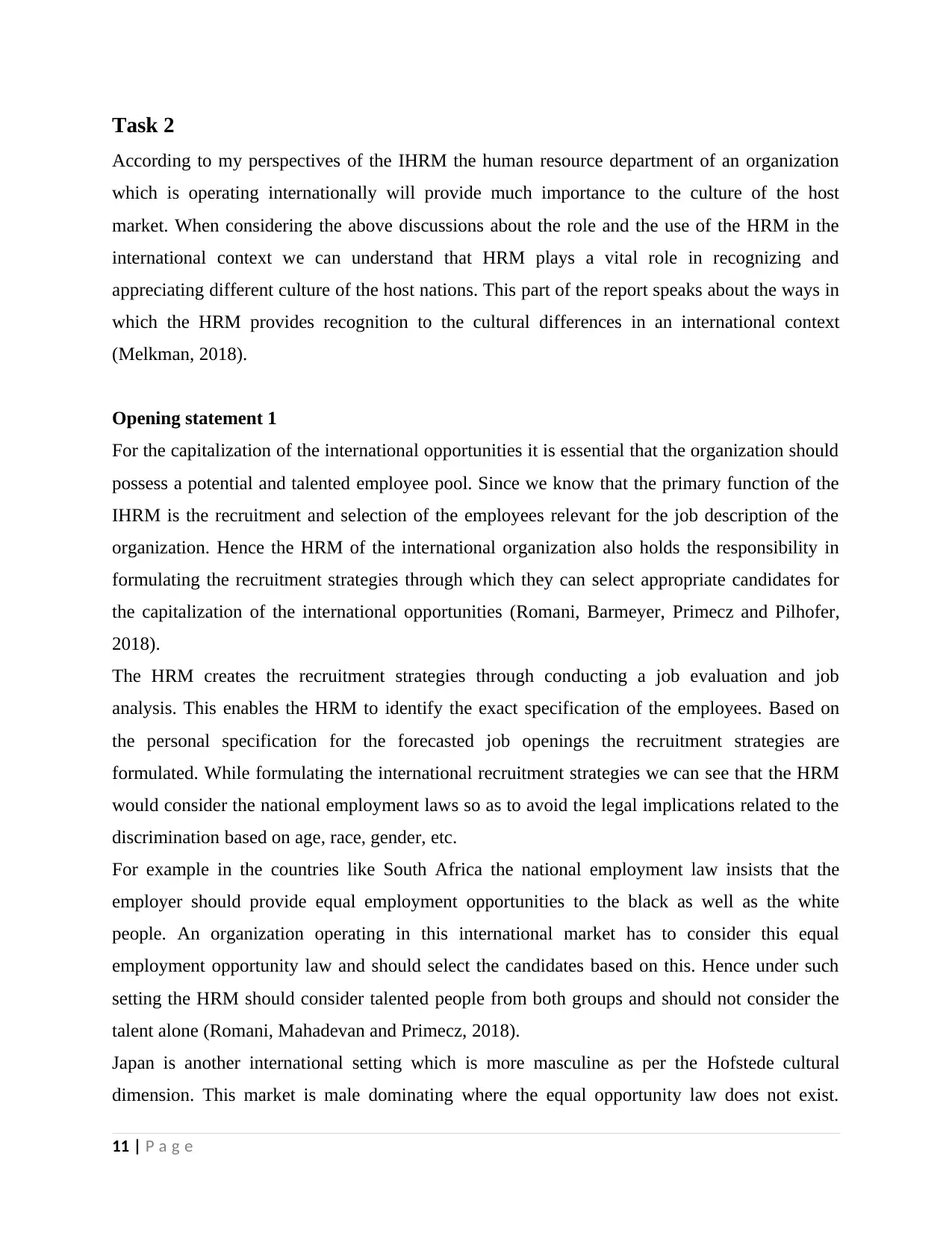
Task 2
According to my perspectives of the IHRM the human resource department of an organization
which is operating internationally will provide much importance to the culture of the host
market. When considering the above discussions about the role and the use of the HRM in the
international context we can understand that HRM plays a vital role in recognizing and
appreciating different culture of the host nations. This part of the report speaks about the ways in
which the HRM provides recognition to the cultural differences in an international context
(Melkman, 2018).
Opening statement 1
For the capitalization of the international opportunities it is essential that the organization should
possess a potential and talented employee pool. Since we know that the primary function of the
IHRM is the recruitment and selection of the employees relevant for the job description of the
organization. Hence the HRM of the international organization also holds the responsibility in
formulating the recruitment strategies through which they can select appropriate candidates for
the capitalization of the international opportunities (Romani, Barmeyer, Primecz and Pilhofer,
2018).
The HRM creates the recruitment strategies through conducting a job evaluation and job
analysis. This enables the HRM to identify the exact specification of the employees. Based on
the personal specification for the forecasted job openings the recruitment strategies are
formulated. While formulating the international recruitment strategies we can see that the HRM
would consider the national employment laws so as to avoid the legal implications related to the
discrimination based on age, race, gender, etc.
For example in the countries like South Africa the national employment law insists that the
employer should provide equal employment opportunities to the black as well as the white
people. An organization operating in this international market has to consider this equal
employment opportunity law and should select the candidates based on this. Hence under such
setting the HRM should consider talented people from both groups and should not consider the
talent alone (Romani, Mahadevan and Primecz, 2018).
Japan is another international setting which is more masculine as per the Hofstede cultural
dimension. This market is male dominating where the equal opportunity law does not exist.
11 | P a g e
According to my perspectives of the IHRM the human resource department of an organization
which is operating internationally will provide much importance to the culture of the host
market. When considering the above discussions about the role and the use of the HRM in the
international context we can understand that HRM plays a vital role in recognizing and
appreciating different culture of the host nations. This part of the report speaks about the ways in
which the HRM provides recognition to the cultural differences in an international context
(Melkman, 2018).
Opening statement 1
For the capitalization of the international opportunities it is essential that the organization should
possess a potential and talented employee pool. Since we know that the primary function of the
IHRM is the recruitment and selection of the employees relevant for the job description of the
organization. Hence the HRM of the international organization also holds the responsibility in
formulating the recruitment strategies through which they can select appropriate candidates for
the capitalization of the international opportunities (Romani, Barmeyer, Primecz and Pilhofer,
2018).
The HRM creates the recruitment strategies through conducting a job evaluation and job
analysis. This enables the HRM to identify the exact specification of the employees. Based on
the personal specification for the forecasted job openings the recruitment strategies are
formulated. While formulating the international recruitment strategies we can see that the HRM
would consider the national employment laws so as to avoid the legal implications related to the
discrimination based on age, race, gender, etc.
For example in the countries like South Africa the national employment law insists that the
employer should provide equal employment opportunities to the black as well as the white
people. An organization operating in this international market has to consider this equal
employment opportunity law and should select the candidates based on this. Hence under such
setting the HRM should consider talented people from both groups and should not consider the
talent alone (Romani, Mahadevan and Primecz, 2018).
Japan is another international setting which is more masculine as per the Hofstede cultural
dimension. This market is male dominating where the equal opportunity law does not exist.
11 | P a g e
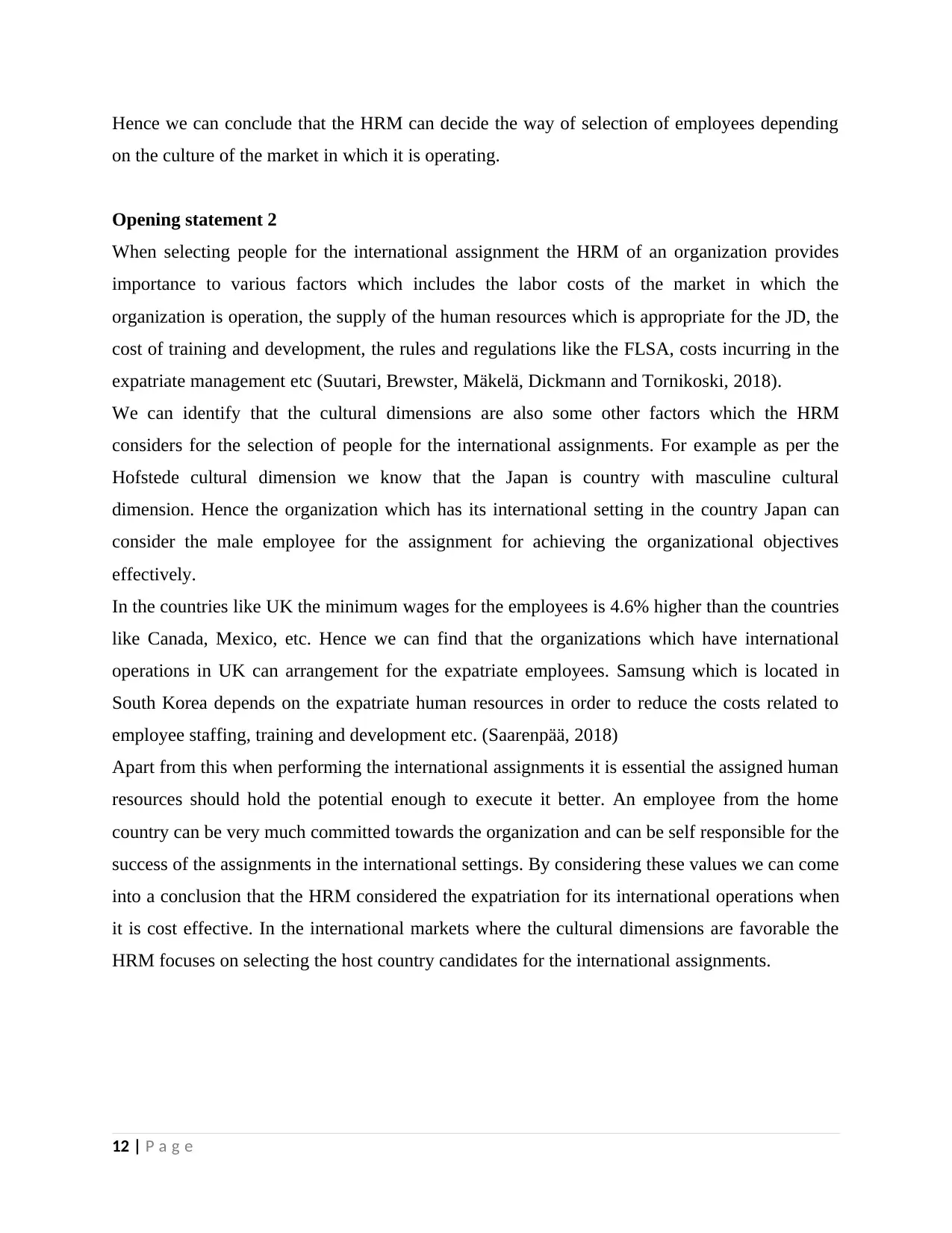
Hence we can conclude that the HRM can decide the way of selection of employees depending
on the culture of the market in which it is operating.
Opening statement 2
When selecting people for the international assignment the HRM of an organization provides
importance to various factors which includes the labor costs of the market in which the
organization is operation, the supply of the human resources which is appropriate for the JD, the
cost of training and development, the rules and regulations like the FLSA, costs incurring in the
expatriate management etc (Suutari, Brewster, Mäkelä, Dickmann and Tornikoski, 2018).
We can identify that the cultural dimensions are also some other factors which the HRM
considers for the selection of people for the international assignments. For example as per the
Hofstede cultural dimension we know that the Japan is country with masculine cultural
dimension. Hence the organization which has its international setting in the country Japan can
consider the male employee for the assignment for achieving the organizational objectives
effectively.
In the countries like UK the minimum wages for the employees is 4.6% higher than the countries
like Canada, Mexico, etc. Hence we can find that the organizations which have international
operations in UK can arrangement for the expatriate employees. Samsung which is located in
South Korea depends on the expatriate human resources in order to reduce the costs related to
employee staffing, training and development etc. (Saarenpää, 2018)
Apart from this when performing the international assignments it is essential the assigned human
resources should hold the potential enough to execute it better. An employee from the home
country can be very much committed towards the organization and can be self responsible for the
success of the assignments in the international settings. By considering these values we can come
into a conclusion that the HRM considered the expatriation for its international operations when
it is cost effective. In the international markets where the cultural dimensions are favorable the
HRM focuses on selecting the host country candidates for the international assignments.
12 | P a g e
on the culture of the market in which it is operating.
Opening statement 2
When selecting people for the international assignment the HRM of an organization provides
importance to various factors which includes the labor costs of the market in which the
organization is operation, the supply of the human resources which is appropriate for the JD, the
cost of training and development, the rules and regulations like the FLSA, costs incurring in the
expatriate management etc (Suutari, Brewster, Mäkelä, Dickmann and Tornikoski, 2018).
We can identify that the cultural dimensions are also some other factors which the HRM
considers for the selection of people for the international assignments. For example as per the
Hofstede cultural dimension we know that the Japan is country with masculine cultural
dimension. Hence the organization which has its international setting in the country Japan can
consider the male employee for the assignment for achieving the organizational objectives
effectively.
In the countries like UK the minimum wages for the employees is 4.6% higher than the countries
like Canada, Mexico, etc. Hence we can find that the organizations which have international
operations in UK can arrangement for the expatriate employees. Samsung which is located in
South Korea depends on the expatriate human resources in order to reduce the costs related to
employee staffing, training and development etc. (Saarenpää, 2018)
Apart from this when performing the international assignments it is essential the assigned human
resources should hold the potential enough to execute it better. An employee from the home
country can be very much committed towards the organization and can be self responsible for the
success of the assignments in the international settings. By considering these values we can come
into a conclusion that the HRM considered the expatriation for its international operations when
it is cost effective. In the international markets where the cultural dimensions are favorable the
HRM focuses on selecting the host country candidates for the international assignments.
12 | P a g e
⊘ This is a preview!⊘
Do you want full access?
Subscribe today to unlock all pages.

Trusted by 1+ million students worldwide
1 out of 19
Related Documents
Your All-in-One AI-Powered Toolkit for Academic Success.
+13062052269
info@desklib.com
Available 24*7 on WhatsApp / Email
![[object Object]](/_next/static/media/star-bottom.7253800d.svg)
Unlock your academic potential
Copyright © 2020–2025 A2Z Services. All Rights Reserved. Developed and managed by ZUCOL.




